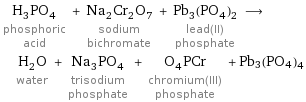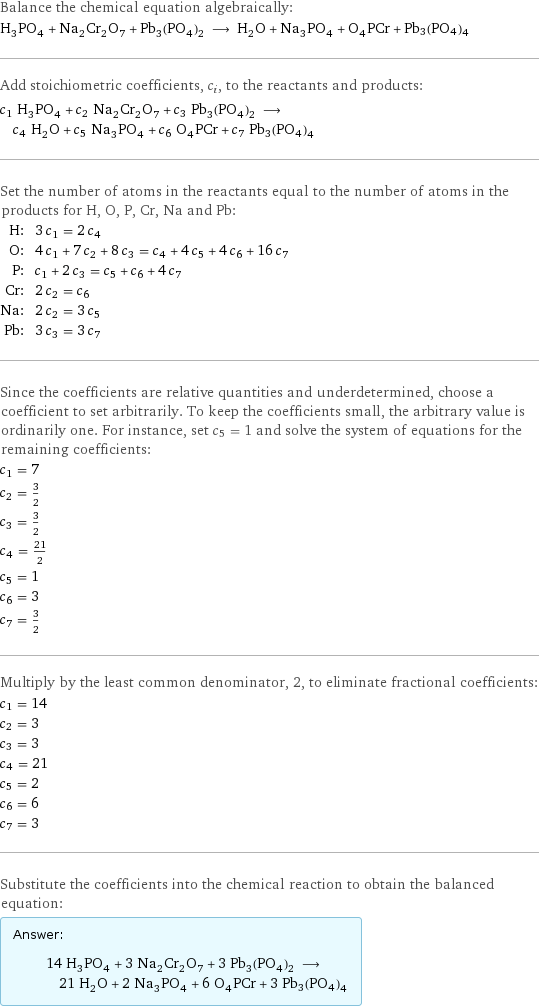Input interpretation

H_3PO_4 phosphoric acid + Na_2Cr_2O_7 sodium bichromate + Pb_3(PO_4)_2 lead(II) phosphate ⟶ H_2O water + Na_3PO_4 trisodium phosphate + O_4PCr chromium(III) phosphate + Pb3(PO4)4
Balanced equation

Balance the chemical equation algebraically: H_3PO_4 + Na_2Cr_2O_7 + Pb_3(PO_4)_2 ⟶ H_2O + Na_3PO_4 + O_4PCr + Pb3(PO4)4 Add stoichiometric coefficients, c_i, to the reactants and products: c_1 H_3PO_4 + c_2 Na_2Cr_2O_7 + c_3 Pb_3(PO_4)_2 ⟶ c_4 H_2O + c_5 Na_3PO_4 + c_6 O_4PCr + c_7 Pb3(PO4)4 Set the number of atoms in the reactants equal to the number of atoms in the products for H, O, P, Cr, Na and Pb: H: | 3 c_1 = 2 c_4 O: | 4 c_1 + 7 c_2 + 8 c_3 = c_4 + 4 c_5 + 4 c_6 + 16 c_7 P: | c_1 + 2 c_3 = c_5 + c_6 + 4 c_7 Cr: | 2 c_2 = c_6 Na: | 2 c_2 = 3 c_5 Pb: | 3 c_3 = 3 c_7 Since the coefficients are relative quantities and underdetermined, choose a coefficient to set arbitrarily. To keep the coefficients small, the arbitrary value is ordinarily one. For instance, set c_5 = 1 and solve the system of equations for the remaining coefficients: c_1 = 7 c_2 = 3/2 c_3 = 3/2 c_4 = 21/2 c_5 = 1 c_6 = 3 c_7 = 3/2 Multiply by the least common denominator, 2, to eliminate fractional coefficients: c_1 = 14 c_2 = 3 c_3 = 3 c_4 = 21 c_5 = 2 c_6 = 6 c_7 = 3 Substitute the coefficients into the chemical reaction to obtain the balanced equation: Answer: | | 14 H_3PO_4 + 3 Na_2Cr_2O_7 + 3 Pb_3(PO_4)_2 ⟶ 21 H_2O + 2 Na_3PO_4 + 6 O_4PCr + 3 Pb3(PO4)4
Structures

+ + ⟶ + + + Pb3(PO4)4
Names

phosphoric acid + sodium bichromate + lead(II) phosphate ⟶ water + trisodium phosphate + chromium(III) phosphate + Pb3(PO4)4
Equilibrium constant
![Construct the equilibrium constant, K, expression for: H_3PO_4 + Na_2Cr_2O_7 + Pb_3(PO_4)_2 ⟶ H_2O + Na_3PO_4 + O_4PCr + Pb3(PO4)4 Plan: • Balance the chemical equation. • Determine the stoichiometric numbers. • Assemble the activity expression for each chemical species. • Use the activity expressions to build the equilibrium constant expression. Write the balanced chemical equation: 14 H_3PO_4 + 3 Na_2Cr_2O_7 + 3 Pb_3(PO_4)_2 ⟶ 21 H_2O + 2 Na_3PO_4 + 6 O_4PCr + 3 Pb3(PO4)4 Assign stoichiometric numbers, ν_i, using the stoichiometric coefficients, c_i, from the balanced chemical equation in the following manner: ν_i = -c_i for reactants and ν_i = c_i for products: chemical species | c_i | ν_i H_3PO_4 | 14 | -14 Na_2Cr_2O_7 | 3 | -3 Pb_3(PO_4)_2 | 3 | -3 H_2O | 21 | 21 Na_3PO_4 | 2 | 2 O_4PCr | 6 | 6 Pb3(PO4)4 | 3 | 3 Assemble the activity expressions accounting for the state of matter and ν_i: chemical species | c_i | ν_i | activity expression H_3PO_4 | 14 | -14 | ([H3PO4])^(-14) Na_2Cr_2O_7 | 3 | -3 | ([Na2Cr2O7])^(-3) Pb_3(PO_4)_2 | 3 | -3 | ([Pb3(PO4)2])^(-3) H_2O | 21 | 21 | ([H2O])^21 Na_3PO_4 | 2 | 2 | ([Na3PO4])^2 O_4PCr | 6 | 6 | ([O4P1Cr1])^6 Pb3(PO4)4 | 3 | 3 | ([Pb3(PO4)4])^3 The equilibrium constant symbol in the concentration basis is: K_c Mulitply the activity expressions to arrive at the K_c expression: Answer: | | K_c = ([H3PO4])^(-14) ([Na2Cr2O7])^(-3) ([Pb3(PO4)2])^(-3) ([H2O])^21 ([Na3PO4])^2 ([O4P1Cr1])^6 ([Pb3(PO4)4])^3 = (([H2O])^21 ([Na3PO4])^2 ([O4P1Cr1])^6 ([Pb3(PO4)4])^3)/(([H3PO4])^14 ([Na2Cr2O7])^3 ([Pb3(PO4)2])^3)](../image_source/e8684d03bc3ceb4198ff2302185e2723.png)
Construct the equilibrium constant, K, expression for: H_3PO_4 + Na_2Cr_2O_7 + Pb_3(PO_4)_2 ⟶ H_2O + Na_3PO_4 + O_4PCr + Pb3(PO4)4 Plan: • Balance the chemical equation. • Determine the stoichiometric numbers. • Assemble the activity expression for each chemical species. • Use the activity expressions to build the equilibrium constant expression. Write the balanced chemical equation: 14 H_3PO_4 + 3 Na_2Cr_2O_7 + 3 Pb_3(PO_4)_2 ⟶ 21 H_2O + 2 Na_3PO_4 + 6 O_4PCr + 3 Pb3(PO4)4 Assign stoichiometric numbers, ν_i, using the stoichiometric coefficients, c_i, from the balanced chemical equation in the following manner: ν_i = -c_i for reactants and ν_i = c_i for products: chemical species | c_i | ν_i H_3PO_4 | 14 | -14 Na_2Cr_2O_7 | 3 | -3 Pb_3(PO_4)_2 | 3 | -3 H_2O | 21 | 21 Na_3PO_4 | 2 | 2 O_4PCr | 6 | 6 Pb3(PO4)4 | 3 | 3 Assemble the activity expressions accounting for the state of matter and ν_i: chemical species | c_i | ν_i | activity expression H_3PO_4 | 14 | -14 | ([H3PO4])^(-14) Na_2Cr_2O_7 | 3 | -3 | ([Na2Cr2O7])^(-3) Pb_3(PO_4)_2 | 3 | -3 | ([Pb3(PO4)2])^(-3) H_2O | 21 | 21 | ([H2O])^21 Na_3PO_4 | 2 | 2 | ([Na3PO4])^2 O_4PCr | 6 | 6 | ([O4P1Cr1])^6 Pb3(PO4)4 | 3 | 3 | ([Pb3(PO4)4])^3 The equilibrium constant symbol in the concentration basis is: K_c Mulitply the activity expressions to arrive at the K_c expression: Answer: | | K_c = ([H3PO4])^(-14) ([Na2Cr2O7])^(-3) ([Pb3(PO4)2])^(-3) ([H2O])^21 ([Na3PO4])^2 ([O4P1Cr1])^6 ([Pb3(PO4)4])^3 = (([H2O])^21 ([Na3PO4])^2 ([O4P1Cr1])^6 ([Pb3(PO4)4])^3)/(([H3PO4])^14 ([Na2Cr2O7])^3 ([Pb3(PO4)2])^3)
Rate of reaction
![Construct the rate of reaction expression for: H_3PO_4 + Na_2Cr_2O_7 + Pb_3(PO_4)_2 ⟶ H_2O + Na_3PO_4 + O_4PCr + Pb3(PO4)4 Plan: • Balance the chemical equation. • Determine the stoichiometric numbers. • Assemble the rate term for each chemical species. • Write the rate of reaction expression. Write the balanced chemical equation: 14 H_3PO_4 + 3 Na_2Cr_2O_7 + 3 Pb_3(PO_4)_2 ⟶ 21 H_2O + 2 Na_3PO_4 + 6 O_4PCr + 3 Pb3(PO4)4 Assign stoichiometric numbers, ν_i, using the stoichiometric coefficients, c_i, from the balanced chemical equation in the following manner: ν_i = -c_i for reactants and ν_i = c_i for products: chemical species | c_i | ν_i H_3PO_4 | 14 | -14 Na_2Cr_2O_7 | 3 | -3 Pb_3(PO_4)_2 | 3 | -3 H_2O | 21 | 21 Na_3PO_4 | 2 | 2 O_4PCr | 6 | 6 Pb3(PO4)4 | 3 | 3 The rate term for each chemical species, B_i, is 1/ν_i(Δ[B_i])/(Δt) where [B_i] is the amount concentration and t is time: chemical species | c_i | ν_i | rate term H_3PO_4 | 14 | -14 | -1/14 (Δ[H3PO4])/(Δt) Na_2Cr_2O_7 | 3 | -3 | -1/3 (Δ[Na2Cr2O7])/(Δt) Pb_3(PO_4)_2 | 3 | -3 | -1/3 (Δ[Pb3(PO4)2])/(Δt) H_2O | 21 | 21 | 1/21 (Δ[H2O])/(Δt) Na_3PO_4 | 2 | 2 | 1/2 (Δ[Na3PO4])/(Δt) O_4PCr | 6 | 6 | 1/6 (Δ[O4P1Cr1])/(Δt) Pb3(PO4)4 | 3 | 3 | 1/3 (Δ[Pb3(PO4)4])/(Δt) (for infinitesimal rate of change, replace Δ with d) Set the rate terms equal to each other to arrive at the rate expression: Answer: | | rate = -1/14 (Δ[H3PO4])/(Δt) = -1/3 (Δ[Na2Cr2O7])/(Δt) = -1/3 (Δ[Pb3(PO4)2])/(Δt) = 1/21 (Δ[H2O])/(Δt) = 1/2 (Δ[Na3PO4])/(Δt) = 1/6 (Δ[O4P1Cr1])/(Δt) = 1/3 (Δ[Pb3(PO4)4])/(Δt) (assuming constant volume and no accumulation of intermediates or side products)](../image_source/83b700c55bbf1d86170200f6ea23fc6c.png)
Construct the rate of reaction expression for: H_3PO_4 + Na_2Cr_2O_7 + Pb_3(PO_4)_2 ⟶ H_2O + Na_3PO_4 + O_4PCr + Pb3(PO4)4 Plan: • Balance the chemical equation. • Determine the stoichiometric numbers. • Assemble the rate term for each chemical species. • Write the rate of reaction expression. Write the balanced chemical equation: 14 H_3PO_4 + 3 Na_2Cr_2O_7 + 3 Pb_3(PO_4)_2 ⟶ 21 H_2O + 2 Na_3PO_4 + 6 O_4PCr + 3 Pb3(PO4)4 Assign stoichiometric numbers, ν_i, using the stoichiometric coefficients, c_i, from the balanced chemical equation in the following manner: ν_i = -c_i for reactants and ν_i = c_i for products: chemical species | c_i | ν_i H_3PO_4 | 14 | -14 Na_2Cr_2O_7 | 3 | -3 Pb_3(PO_4)_2 | 3 | -3 H_2O | 21 | 21 Na_3PO_4 | 2 | 2 O_4PCr | 6 | 6 Pb3(PO4)4 | 3 | 3 The rate term for each chemical species, B_i, is 1/ν_i(Δ[B_i])/(Δt) where [B_i] is the amount concentration and t is time: chemical species | c_i | ν_i | rate term H_3PO_4 | 14 | -14 | -1/14 (Δ[H3PO4])/(Δt) Na_2Cr_2O_7 | 3 | -3 | -1/3 (Δ[Na2Cr2O7])/(Δt) Pb_3(PO_4)_2 | 3 | -3 | -1/3 (Δ[Pb3(PO4)2])/(Δt) H_2O | 21 | 21 | 1/21 (Δ[H2O])/(Δt) Na_3PO_4 | 2 | 2 | 1/2 (Δ[Na3PO4])/(Δt) O_4PCr | 6 | 6 | 1/6 (Δ[O4P1Cr1])/(Δt) Pb3(PO4)4 | 3 | 3 | 1/3 (Δ[Pb3(PO4)4])/(Δt) (for infinitesimal rate of change, replace Δ with d) Set the rate terms equal to each other to arrive at the rate expression: Answer: | | rate = -1/14 (Δ[H3PO4])/(Δt) = -1/3 (Δ[Na2Cr2O7])/(Δt) = -1/3 (Δ[Pb3(PO4)2])/(Δt) = 1/21 (Δ[H2O])/(Δt) = 1/2 (Δ[Na3PO4])/(Δt) = 1/6 (Δ[O4P1Cr1])/(Δt) = 1/3 (Δ[Pb3(PO4)4])/(Δt) (assuming constant volume and no accumulation of intermediates or side products)
Chemical names and formulas

| phosphoric acid | sodium bichromate | lead(II) phosphate | water | trisodium phosphate | chromium(III) phosphate | Pb3(PO4)4 formula | H_3PO_4 | Na_2Cr_2O_7 | Pb_3(PO_4)_2 | H_2O | Na_3PO_4 | O_4PCr | Pb3(PO4)4 Hill formula | H_3O_4P | Cr_2Na_2O_7 | O_8P_2Pb_3 | H_2O | Na_3O_4P | CrO_4P | O16P4Pb3 name | phosphoric acid | sodium bichromate | lead(II) phosphate | water | trisodium phosphate | chromium(III) phosphate | IUPAC name | phosphoric acid | disodium oxido-(oxido-dioxo-chromio)oxy-dioxo-chromium | lead(+2) cation diphosphate | water | trisodium phosphate | chromium(3+) phosphate |
Substance properties

| phosphoric acid | sodium bichromate | lead(II) phosphate | water | trisodium phosphate | chromium(III) phosphate | Pb3(PO4)4 molar mass | 97.994 g/mol | 261.96 g/mol | 811.5 g/mol | 18.015 g/mol | 163.94 g/mol | 146.97 g/mol | 1001 g/mol phase | liquid (at STP) | solid (at STP) | solid (at STP) | liquid (at STP) | solid (at STP) | | melting point | 42.4 °C | 356.7 °C | 1290 °C | 0 °C | 75 °C | | boiling point | 158 °C | | | 99.9839 °C | | | density | 1.685 g/cm^3 | 2.35 g/cm^3 | 6.9 g/cm^3 | 1 g/cm^3 | 2.536 g/cm^3 | | solubility in water | very soluble | | | | soluble | | surface tension | | | | 0.0728 N/m | | | dynamic viscosity | | | | 8.9×10^-4 Pa s (at 25 °C) | | | odor | odorless | | | odorless | odorless | |
Units
